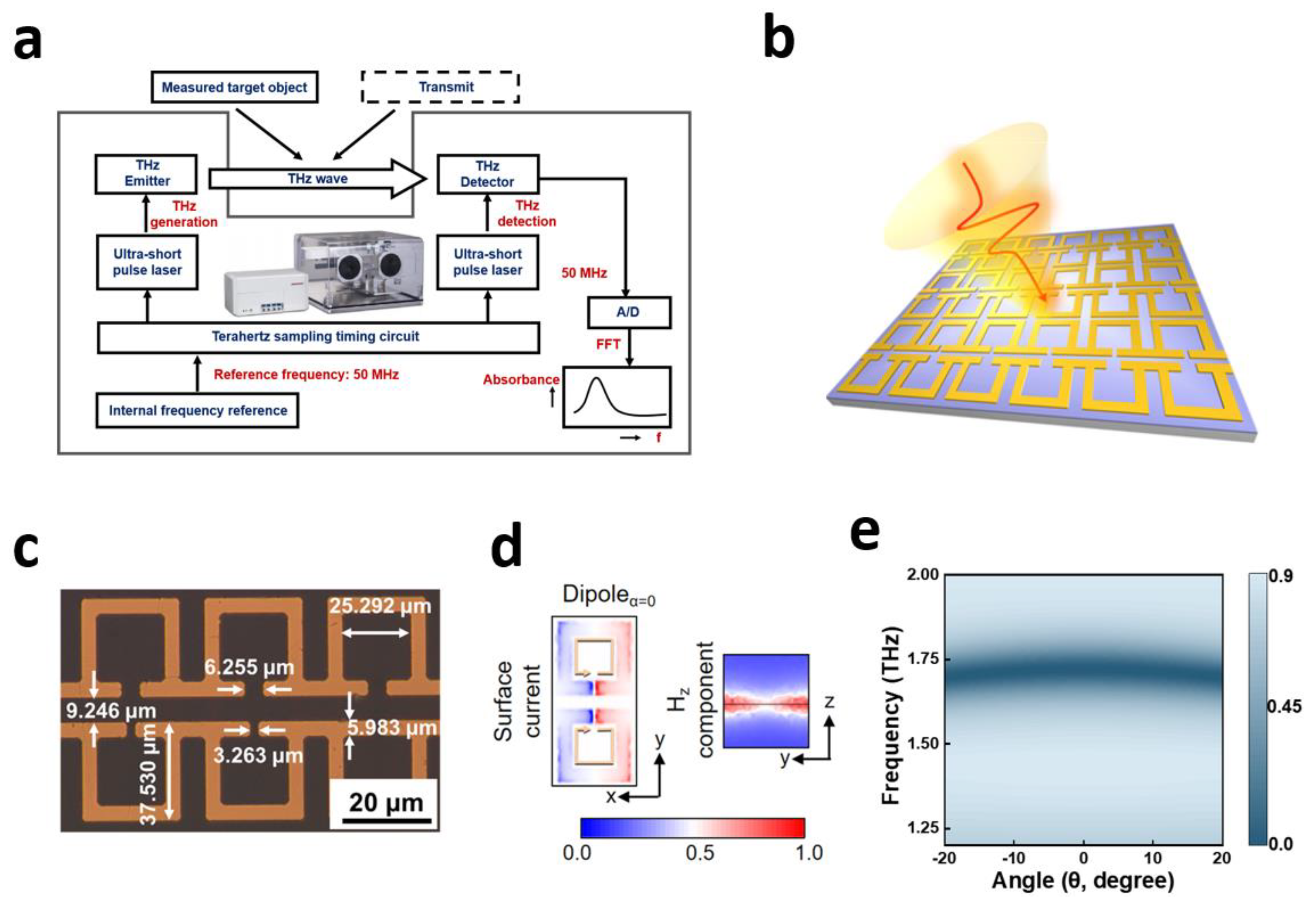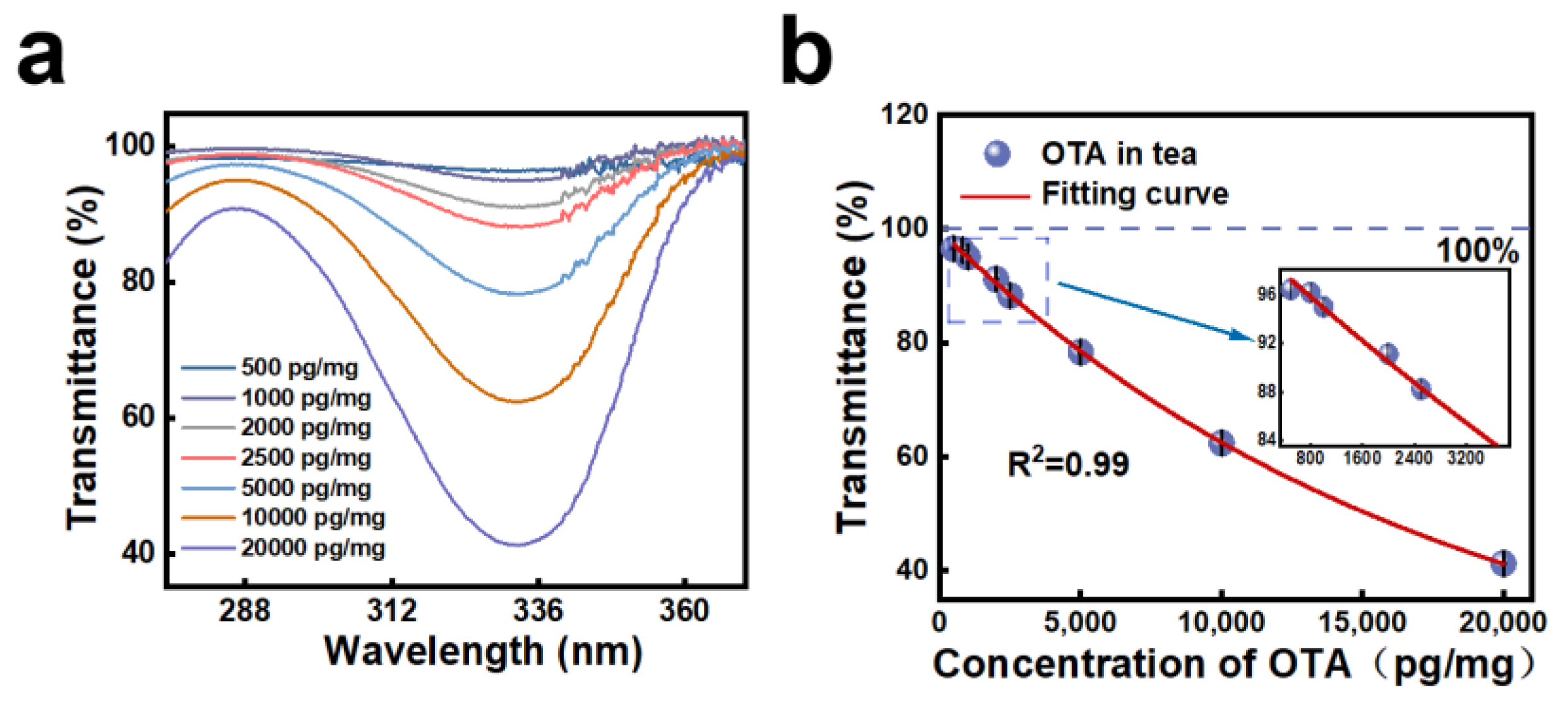Rapid Determination of Ochratoxin A in Black Tea Using Terahertz Ultrasensitive Biosensor
Abstract
:1. Introduction
2. Materials and Methods
2.1. Sample Preparation
2.2. Terahertz Spectroscopy System
2.3. SPR Biosensor
2.4. UV Spectrophotometric System
2.5. Data Processing and Analysis
3. Results and Discussion
3.1. Spectra Analysis
3.2. Detection of Ochratoxin A in Acetonitrile
3.3. Detection of Ochratoxin A in Black Tea
3.4. Comparison with UV Spectroscopy
4. Conclusions
Author Contributions
Funding
Institutional Review Board Statement
Informed Consent Statement
Data Availability Statement
Conflicts of Interest
References
- Lyu, H.; Sun, H.; Zhu, Y.; Wang, J.; Xie, Z.; Li, J. A double-recognized aptamer-molecularly imprinted monolithic column for high-specificity recognition of ochratoxin A. Anal. Chim. Acta. 2020, 1103, 97–105. [Google Scholar] [CrossRef] [PubMed]
- Wang, L.; Hua, X.; Shi, J.; Jing, N.; Ji, T.; Lv, B.; Liu, L.; Chen, Y. Ochratoxin A: Occurrence and recent advances in detoxification. Toxicon 2022, 210, 11–18. [Google Scholar] [CrossRef] [PubMed]
- Li, X.; Ma, W.; Ma, Z.; Zhang, Q.; Li, H. The Occurrence and Contamination Level of Ochratoxin A in Plant and Animal-Derived Food Commodities. Molecules 2021, 26, 6928. [Google Scholar] [CrossRef] [PubMed]
- Wang, L.; Wang, Q.; Wang, S.; Cai, R.; Yuan, Y.; Yue, T.; Wang, Z. Bio-control on the contamination of Ochratoxin A in food: Current research and future prospects. Curr. Res. Food Sci. 2022, 5, 1539–1549. [Google Scholar] [CrossRef]
- Obafemi, B.A.; Adedara, I.A.; Rocha, J.B.T. Neurotoxicity of ochratoxin A: Molecular mechanisms and neurotherapeutic strategies. Toxicology 2023, 497–498, 153630. [Google Scholar] [CrossRef]
- Chen, X.; Gao, D.; Sun, F.; Li, Z.; Wang, Y.; Qiu, C.; He, K.; Wang, J. Nanomaterial-based aptamer biosensors for ochratoxin A detection: A review. Anal. Bioanal. Chem. 2022, 414, 2953–2969. [Google Scholar] [CrossRef]
- Nourbakhsh, F.; Tajbakhsh, E. Neurotoxicity mechanism of Ochratoxin A. Qual. Assur. Saf. Crop. Foods 2021, 13, 34–45. [Google Scholar] [CrossRef]
- Heussner, A.H.; Bingle, L.E. Comparative Ochratoxin Toxicity: A Review of the Available Data. Toxins 2015, 7, 4253–4282. [Google Scholar] [CrossRef]
- Cai, H.; Zhong, Z.; Li, Z.; Zhang, X.; Fu, H.; Yang, B.; Zhang, L. Metabolomics in quality formation and characterisation of tea products: A review. Int. J. Food Sci. Technol. 2022, 57, 4001–4014. [Google Scholar] [CrossRef]
- Kosicki, R.; Buharowska-Donten, J.; Twaruzek, M. Ochratoxin A levels in serum of Polish dialysis patients with chronic renal failure. Toxicon 2021, 200, 183–188. [Google Scholar] [CrossRef]
- The European Commission. Commission Regulation (EU) 2023/915 of 25 April 2023 on Maximum Levels for Certain Contaminants in Food and Repealing Regulation (EC) No 1881/2006; The European Commission: Brussels, Belgium, 2023; pp. 115–117.
- Torabi, R.; Ali Rezvanipour, A.; Esmaeili Gouvarchinghaleh, H.; Ranjbar, R.; Heiat, M. Aptamer based detection and separation platforms for ochratoxin A: A systematic review. Biocell 2022, 46, 2537–2557. [Google Scholar] [CrossRef]
- Zhang, K. Comparison of Flow Injection-MS/MS and LC-MS/MS for the Determination of Ochratoxin A. Toxins 2021, 13, 547. [Google Scholar] [CrossRef] [PubMed]
- Cina, M.; Ponce, M.D.V.; Martinez, L.D.; Cerutti, S. Development of a novel UHPLC-MS/MS method for the determination of ochratoxin A in tea. Heliyon 2021, 7, e06663. [Google Scholar] [CrossRef]
- Zeng, H.; Zhang, M. Determination of Ochratoxin A in Black Tea by Liquid-Liquid Extraction HPLC. Beverage Ind. 2023, 26, 25–28. [Google Scholar]
- Yu, H.; Wang, Q.; Lin, L.; Xu, H.; Zhang, Z. Establishment of a rapid detection method for Ochratoxins A in cassava leaf meal. J. Food Saf. Qual. 2019, 10, 8242–8249. [Google Scholar]
- Li, W.; Nong, R.; Shen, Y.; Li, J.; Ran, Y.; Chen, J.; Zhang, M. Determination of ochratoxin A in Pu-erh tea by ultra performance liquid chromatography-tandem mass spectrometry. J. Food Saf. Qual. 2021, 6, 2240–2245. [Google Scholar]
- Hu, S.; Sun, C.; Wu, X.; Peng, Y. Polarization-Independent Terahertz Surface Plasmon Resonance Biosensor for Species Identification of Panax and Paeonia. Photonics 2023, 10, 250. [Google Scholar] [CrossRef]
- Sudjatmiko, S.; Hadi, S.; Khairunnisa, A.; Nastiti, K.; Yansen; Zarkani, A. Descriminant analysis of flowers, leaves, stems of combretum indicum varr.M and Varr.B with UV-vis spectrophotometric chemometric method. E3S Web Conf. 2023, 373, 03024. [Google Scholar]
- Wang, P.; Yu, Z. Species authentication and geographical origin discrimination of herbal medicines by near infrared spectroscopy: A review. J. Pharm. Anal. 2015, 5, 277–284. [Google Scholar] [CrossRef]
- Lima, C.; Muhamadali, H.; Goodacre, R. The Role of Raman Spectroscopy Within Quantitative Metabolomics. Annu. Rev. Anal. Chem. 2021, 14, 323–345. [Google Scholar] [CrossRef]
- Zhu, Y.; Zang, X.; Chi, H.; Zhou, Y.; Zhu, Y.; Zhuang, S. Metasurfaces designed by a bidirectional deep neural network and iterative algorithm for generating quantitative field distributions. Light Adv. Manuf. 2023, 4, 9. [Google Scholar] [CrossRef]
- Zang, X.; Yao, B.; Chen, L.; Xie, J.; Guo, X.; Balakin, A.V.; Shkurinov, A.P.; Zhuang, S. Metasurfaces for manipulating terahertz waves. Light Adv. Manuf. 2021, 2, 10. [Google Scholar] [CrossRef]
- Deng, Y.; Sun, Q.; Li, C.; Wang, Y.; Zhang, C.; Zhang, X.; Huang, Z.; Tang, L.; Li, Z.; Tang, X. Calibration of terahertz time-domain spectrometers and terahertz radiometry. In Proceedings of the 2021 International Conference on Optical Instruments and Technology: IRMMW-THz Technologies and Applications, Online, 8–10 April 2022; Volume 12284, p. 1228403. [Google Scholar]
- Choi, G.; Lee, D.-H.; Park, I.; Kang, D.; Lee, H.K.; Rhie, J.; Bahk, Y.M. Evaluation of moisturizing cream using terahertz time-domain spectroscopy. Curr. Appl. Phys. 2022, 39, 84–89. [Google Scholar] [CrossRef]
- Meng, D.; Liu, J.; Chen, W.; Cheng, Y.; You, K.; Fan, Z.; Ye, Q.; Huang, P.; Chen, Y. Study on the enhancement mechanism of terahertz molecular fingerprint sensing. Results Phys. 2022, 39, 105766. [Google Scholar] [CrossRef]
- Zhang, X.; Liu, J.; Qin, J. A terahertz metasurface sensor with fingerprint enhancement in a wide spectrum band for thin film detection. Nanoscale Adv. 2023, 5, 2210–2215. [Google Scholar] [CrossRef]
- Li, X.; Ma, C.; Yan, D.; Guo, S.; Zhang, L.; Yang, J.; Zhao, Y.; Zhou, W. Enhanced trace-amount terahertz vibrational absorption spectroscopy using surface spoof polarization in metasurface structures. Opt. Lett. 2022, 47, 2446–2449. [Google Scholar] [CrossRef]
- Islam, M.S.; Sultana, J.; Dinovitser, A.; Ahmed, K.; Ng, B.W.H.; Abbott, D. Sensing of toxic chemicals using polarized photonic crystal fiber in the terahertz regime. Opt. Commun. 2018, 426, 341–347. [Google Scholar] [CrossRef]
- Sun, Y.; Huang, J.; Shan, L.; Fan, S.; Zhu, Z.; Liu, X. Quantitative analysis of bisphenol analogue mixtures by terahertz spectroscopy using machine learning method. Food Chem. 2021, 352, 129313. [Google Scholar] [CrossRef]
- Xu, W.; Wang, Q.; Zhou, R.; Hameed, S.; Ma, Y.; Lijuan, X.; Ying, Y. Defect-rich graphene-coated metamaterial device for pesticide sensing in rice. RSC Adv. 2022, 12, 28678–28684. [Google Scholar] [CrossRef]
- Shou, Y.; Wang, Y.; Miao, L.; Chen, S.; Luo, H. Realization of all-optical higher-order spatial differentiators based on cascaded operations. Optics Letters. 2022, 47, 5981–5984. [Google Scholar] [CrossRef]
- Silalahi, H.M.; Chiang, W.F.; Shih, Y.H.; Wei, W.Y.; Su, J.Y.; Huang, C.Y. Folding metamaterials with extremely strong electromagnetic resonance. Photonics Res. 2022, 10, 2215–2222. [Google Scholar] [CrossRef]
- Zhao, F.; Li, Z.; Li, S.; Dai, X.; Zhou, Y.; Liao, X.; Cao, J.; Liang, G.; Shang, Z.; Zhang, Z.; et al. Terahertz metalens of hyper-dispersion. Photonics Res. 2022, 10, 886–895. [Google Scholar] [CrossRef]
- Chiang, W.F.; Silalahi, H.M.; Chiang, Y.-C.; Hsu, M.C.; Zhang, Y.S.; Liu, J.H.; Yu, Y.; Lee, C.R.; Huang, C.Y. Continuously tunable intensity modulators with large switching contrasts using liquid crystal elastomer films that are deposited with terahertz metamaterials. Optics Express 2020, 28, 27676–27687. [Google Scholar] [CrossRef] [PubMed]
- Liu, S.; Xu, F.; Zhan, J.; Qiang, J.; Xie, Q.; Yang, L.; Deng, S.; Zhang, Y. Terahertz liquid crystal programmable metasurface based on resonance switching. Optics Letters 2022, 47, 1891–1894. [Google Scholar] [CrossRef] [PubMed]
- Pan, Y.; Lan, F.; Zhang, Y.; Zeng, H.; Wang, L.; Song, T.; He, G.; Yang, Z. Dual-band multifunctional coding metasurface with a mingled anisotropic aperture for polarized manipulation in full space. Photonics Res. 2022, 10, 416–425. [Google Scholar] [CrossRef]
- Yudistira, H.T.; Ginting, L.Y.; Kananda, K. High absorbance performance of symmetrical split ring resonator (SRR) terahertz metamaterial based on paper as spacer. Mater. Res. Express 2018, 6, 025804. [Google Scholar] [CrossRef]
- Peng, Y.; Huang, J.; Luo, J.; Yang, Z.; Wang, L.; Wu, X.; Zang, X.; Yu, C.; Gu, M.; Hu, Q.; et al. Three-step one-way model in terahertz biomedical detection. PhotoniX 2021, 2, 12. [Google Scholar] [CrossRef]
- Cui, Y.; Lai, G.; Wen, M.; Han, Z.; Zhang, L. Identification of low-molecular-weight color contributors of black tea infusion by metabolomics analysis based on UV-visible spectroscopy and mass spectrometry. Food Chem. 2022, 386, 132788. [Google Scholar] [CrossRef]
- Liu, B.; Peng, Y.; Jin, Z.; Wu, X.; Gu, H.; Wei, D.; Zhu, Y.; Zhuang, S. Terahertz ultrasensitive biosensor based on wide-area and intense light-matter interaction supported by QBIC. Chem. Eng. J. 2023, 462, 142347. [Google Scholar] [CrossRef]
- Tang, C.; Yang, J.; Wang, Y.; Cheng, J.; Li, X.; Chang, C.; Hu, J.; Lü, J. Integrating terahertz metamaterial and water nanodroplets for ultrasensitive detection of amyloid β aggregates in liquids. Sens. Actuators B Chem. 2021, 329, 129113. [Google Scholar] [CrossRef]
- Yang, K.; Li, J.; Lamy de la Chapelle, M.; Huang, G.; Wang, Y.; Zhang, J.; Xu, D.; Yao, J.; Yang, X.; Fu, W. A terahertz metamaterial biosensor for sensitive detection of microRNAs based on gold-nanoparticles and strand displacement amplification. Biosens. Bioelectron. 2021, 175, 112874. [Google Scholar] [CrossRef] [PubMed]
- Aschl, T.; Frison, G.; Moraillon, A.; Ozanam, F.; Allongue, P.; Gouget-Laemmel, A.C. Insights into the Ochratoxin A/Aptamer Interactions on a Functionalized Silicon Surface by Fourier Transform Infrared and UV-Vis Studies. Langmuir 2020, 36, 13908–13917. [Google Scholar] [CrossRef]




Disclaimer/Publisher’s Note: The statements, opinions and data contained in all publications are solely those of the individual author(s) and contributor(s) and not of MDPI and/or the editor(s). MDPI and/or the editor(s) disclaim responsibility for any injury to people or property resulting from any ideas, methods, instructions or products referred to in the content. |
© 2023 by the authors. Licensee MDPI, Basel, Switzerland. This article is an open access article distributed under the terms and conditions of the Creative Commons Attribution (CC BY) license (https://creativecommons.org/licenses/by/4.0/).
Share and Cite
Chen, G.; Liu, B.; Lu, P.; Peng, Y. Rapid Determination of Ochratoxin A in Black Tea Using Terahertz Ultrasensitive Biosensor. Photonics 2024, 11, 9. https://doi.org/10.3390/photonics11010009
Chen G, Liu B, Lu P, Peng Y. Rapid Determination of Ochratoxin A in Black Tea Using Terahertz Ultrasensitive Biosensor. Photonics. 2024; 11(1):9. https://doi.org/10.3390/photonics11010009
Chicago/Turabian StyleChen, Gan, Bingwei Liu, Ping Lu, and Yan Peng. 2024. "Rapid Determination of Ochratoxin A in Black Tea Using Terahertz Ultrasensitive Biosensor" Photonics 11, no. 1: 9. https://doi.org/10.3390/photonics11010009
APA StyleChen, G., Liu, B., Lu, P., & Peng, Y. (2024). Rapid Determination of Ochratoxin A in Black Tea Using Terahertz Ultrasensitive Biosensor. Photonics, 11(1), 9. https://doi.org/10.3390/photonics11010009





